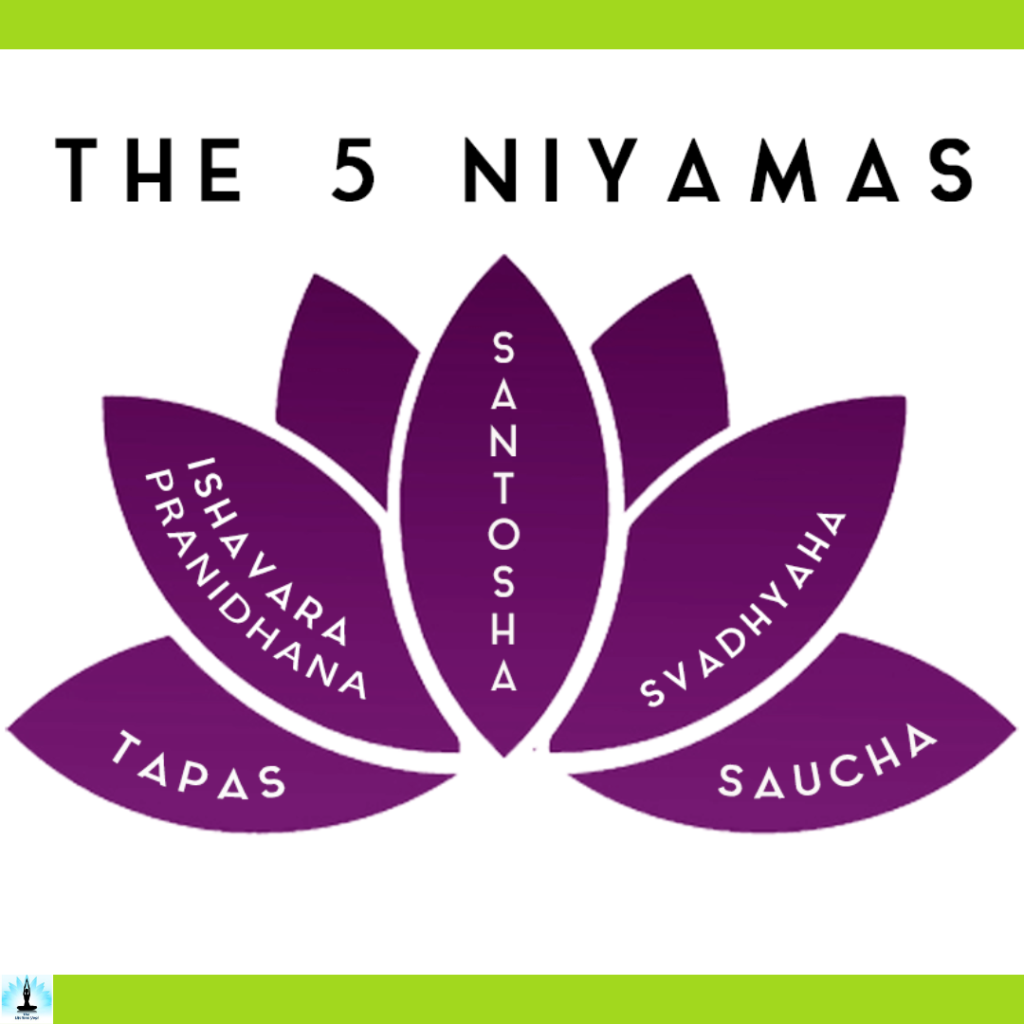Introduction – Transformative 5 Niyamas of Yoga – Definition & Practice Tips
Yoga, beyond the physical postures and breathwork, encompasses a rich philosophy that guides practitioners toward holistic well-being. Among the foundational principles of yogic philosophy are the Niyamas—ethical guidelines that provide a roadmap for personal and spiritual growth. Let’s delve into the essence of the Niyamas and explore practical tips for weaving them into your yoga journey.
Table of Contents
Understanding the Niyamas

Derived from the ancient yogic text, the Yoga Sutras of Patanjali, the Niyamas are the second limb of the eightfold path of yoga. These principles offer guidance on how we should relate to ourselves and the world around us. The Niyamas consist of five key components, each fostering a different aspect of our inner development.
Saucha (Purity/Cleanliness)
Saucha encourages cleanliness, both externally and internally. Externally, it involves maintaining physical cleanliness through personal hygiene and a clean environment. Internally, it extends to purifying our thoughts, emotions, and intentions. Embrace practices like regular cleansing routines, a balanced diet, and mindfulness to cultivate Saucha.
Santosha (Contentment)
Santosha invites us to find contentment and gratitude in the present moment. It’s about appreciating what we have rather than dwelling on what we lack. Foster Santosha by practicing gratitude daily, acknowledging small joys, and cultivating a positive mindset. Recognize that contentment is a state of mind, not dependent on external circumstances.
Tapas (Discipline)
Tapas is the fire of discipline that fuels our spiritual journey. It involves cultivating self-discipline, determination, and resilience. Engage in practices that challenge you, whether through physical asanas, meditation, or mindful living. Embrace the discomfort as a path to personal growth and transformation.
Svadhyaya (Self-Study)
Svadhyaya encourages the exploration of self through study and introspection. It involves reading sacred texts, self-reflection, and gaining knowledge about your inner world. Journaling, meditation, and reading philosophical texts are powerful ways to embark on the journey of self-discovery.
Ishvara Pranidhana (Surrender to the Divine)
Ishvara Pranidhana invites us to surrender our ego and individual will to a higher power or divine source. This doesn’t necessarily mean aligning with a particular religious belief but acknowledging a force beyond the self. Practice surrender through prayer, meditation, or by cultivating humility in your interactions with others.
Practical Tips for Nurturing the Niyamas

Create a Sacred Space
Designate a clean, serene space for your yoga and meditation practice. This external purity can contribute to internal clarity and focus.
Practice Gratitude Rituals
Develop a daily gratitude practice. Whether through a journal or a mental acknowledgment, regularly express thanks for the positive aspects of your life.
Set Realistic Goals
Cultivate discipline by setting achievable goals for your yoga practice. Consistency, even in small steps, builds the fire of discipline over time.
Read Inspirational Texts
Incorporate self-study by reading spiritual or philosophical texts. Choose literature that resonates with you and prompts introspection.
Let Go of Control
Surrender doesn’t mean giving up; it’s about releasing unnecessary control. Practice letting go of attachment to outcomes and trust the process.
The Niyamas serve as a guide for transforming our inner landscape, fostering a harmonious relationship with ourselves and the world. By integrating these principles into our yoga practice and daily life, we embark on a journey of self-discovery and spiritual evolution.
Tips for Practicing the 5 Niyamas in Your Yoga Journey
Embarking on a yogic journey involves more than mastering physical postures; it’s a holistic path that encompasses ethical guidelines for personal and spiritual growth. The Niyamas, the second limb of the eightfold path of yoga, offer profound principles for inner development. Here are practical tips to weave the five Niyamas into your practice:
1. Saucha (Purity/Cleanliness)
- Cleanse Your Physical Space: Create a dedicated and clean space for your yoga and meditation practice. A clutter-free environment fosters mental clarity.
- Mindful Hygiene: Embrace personal hygiene practices mindfully. Pay attention to cleanliness in daily routines to promote physical and mental well-being.
- Nutritional Consciousness: Consider your diet as a form of saucha. Consume nourishing foods that support your overall health and energy.
2. Santosha (Contentment)
- Gratitude Journal: Maintain a gratitude journal. Each day, jot down things you’re thankful for, fostering contentment and shifting your focus to positivity.
- Celebrate Small Wins: Acknowledge and celebrate your achievements, no matter how small. Cultivate contentment by appreciating your progress.
3. Tapas (Discipline)
- Consistent Practice: Establish a consistent yoga practice. Set a realistic schedule and commit to it, cultivating discipline in both your physical and mental practices.
- Challenge Yourself: Integrate challenging asanas or meditation techniques. Embrace discomfort as a path to personal growth and increased discipline.
- Create Rituals: Develop rituals that signify commitment, such as a specific time for practice or a dedicated space. Rituals enhance discipline by creating structure.
4. Svadhyaya (Self-Study)
- Journaling: Maintain a yoga journal to reflect on your practice, thoughts, and emotions. Journaling promotes self-awareness and deeper understanding.
- Read Yogic Literature: Engage in self-study by exploring yogic texts and philosophical literature. Choose books that resonate with your journey for an enriching experience.
- Meditative Reflection: Incorporate meditation into your practice, focusing on self-reflection and gaining insights into your inner world.
5. Ishvara Pranidhana (Surrender to the Divine)
- Mindful Surrender: Practice surrender by letting go of attachment to outcomes. Cultivate an attitude of acceptance and trust in the greater flow of life.
- Devotional Practices: Explore devotional practices that align with your beliefs. This might include prayer, chanting, or rituals that symbolize surrender to a higher power.
- Humility in Interactions: Foster humility in your interactions with others. Approach relationships with openness and a willingness to learn, embracing the concept of surrender.
Goals of the Niyamas
The goals of the Niyamas, comprising Saucha, Santosha, Tapas, Svadhyaya, and Ishvara Pranidhana, collectively aim to foster a holistic approach to life on the yogic path.
- Saucha seeks the purification of body, mind, and surroundings, establishing a harmonious connection between inner and outer worlds.
- Santosha encourages contentment, cultivating a mindset that finds joy in the present moment.
- Tapas instills discipline and perseverance, aiding in overcoming challenges on the path of self-realization.
- Svadhyaya focuses on self-reflection, fostering self-awareness and a deep understanding of one’s nature.
- Ishvara Pranidhana involves surrender to the divine, promoting humility and trust in a higher wisdom. Together, these Niyamas guide practitioners toward ethical living, self-discipline, and spiritual growth, contributing to the overarching goal of attaining inner harmony, self-realization, and union with the divine.
FAQs on ” Transformative 5 Niyamas of Yoga: Definition & Practice Tips”
What Are the Niyamas in Yoga?
The Niyamas are the second limb of the eightfold path in yoga philosophy, representing ethical principles and personal observances. They consist of Saucha (cleanliness), Santosha (contentment), Tapas (discipline), Svadhyaya (self-study), and Ishvara Pranidhana (surrender to the divine).
How Do the Niyamas Contribute to Spiritual Growth?
The Niyamas guide individuals on a path of self-discovery and spiritual development. They encourage a balanced and ethical lifestyle, fostering qualities like contentment, discipline, self-reflection, and surrender to a higher power, all of which contribute to inner growth and a deeper connection to the divine.
What is the significance of Saucha in the Niyamas?
Saucha, or cleanliness, involves purification of body, mind, and surroundings. This Niyama emphasizes the importance of maintaining physical and mental hygiene, creating a conducive environment for spiritual practices, and promoting overall well-being.
How Can One Practice Santosha in Daily Life?
Santosha, or contentment, is cultivated by appreciating and finding joy in the present moment. Practitioners can develop Santosha by practicing gratitude, accepting things as they are, and recognizing the abundance in their lives, fostering contentment irrespective of external circumstances.
What does Tapas entail in the context of the Niyamas?
Tapas, or discipline, involves the fiery effort required for personal transformation. It encourages practitioners to cultivate self-discipline, perseverance, and determination in their yogic journey, leading to inner strength and growth.
How Does Svadhyaya Contribute to Self-Awareness?
Svadhyaya, or self-study, involves introspection and self-reflection. By exploring one’s thoughts, actions, and motivations, individuals gain a deeper understanding of themselves, fostering self-awareness and facilitating personal growth.
What does Ishvara Pranidhana mean in the context of the Niyamas?
Ishvara Pranidhana, or surrender to the divine, emphasizes humility and trust in a higher power. This Niyama encourages practitioners to release the ego, surrendering control and acknowledging a greater wisdom at play in the universe.
How Can One Incorporate the Niyamas into A Daily Yoga Practice?
Practicing the Niyamas involves conscious effort and mindfulness. Individuals can integrate them into their daily lives through activities such as maintaining cleanliness, practicing gratitude, setting and adhering to personal goals, engaging in self-reflection, and cultivating a sense of surrender and humility in their spiritual pursuits.
Can the Niyamas be adapted to different lifestyles and belief systems?
Yes, the Niyamas provide flexible principles that can be adapted to various lifestyles and belief systems. While rooted in traditional yogic philosophy, their essence is universal, offering guidance for ethical and spiritual living irrespective of cultural or religious backgrounds.
How do the Niyamas complement the other limbs of yoga?
The Niyamas, along with the other limbs of yoga, collectively contribute to the holistic development of an individual. They support the ethical and spiritual foundation needed for the practice of yoga, creating a harmonious progression toward self-realization and union with the divine.
Conclusion
In conclusion, the Niyamas form an integral part of the yogic path, offering a roadmap for ethical living and spiritual growth. Saucha, Santosha, Tapas, Svadhyaya, and Ishvara Pranidhana collectively guide practitioners toward a more conscious and fulfilling life. Embracing cleanliness, contentment, discipline, self-study, and surrender to the divine, individuals can cultivate a balanced and harmonious existence.
The practice tips associated with each Niyama provide practical insights for weaving these principles into daily life, fostering self-awareness, resilience, and a deeper connection to the spiritual dimensions of existence. As individuals embark on their yogic journey, the Niyamas stand as beacons, illuminating the path toward inner transformation, personal well-being, and a more profound understanding of the interconnectedness of all aspects of life.
References
- https://www.ncbi.nlm.nih.gov/pmc/articles/PMC4959332/
- https://pubmed.ncbi.nlm.nih.gov/33461204/
- https://www.ncbi.nlm.nih.gov/pmc/articles/PMC4067931/
- https://www.ncbi.nlm.nih.gov/pmc/articles/PMC8191223/
- https://www.ncbi.nlm.nih.gov/pmc/articles/PMC3573536/
- https://www.ncbi.nlm.nih.gov/pmc/articles/PMC4959322/
- https://www.ncbi.nlm.nih.gov/pmc/articles/PMC10357898/
- Vivekananda, p. 115.
- The Yoga-darsana: The sutras of Patanjali with the Bhasya of Vyasa – Book 3 GN Jha (Translator); Harvard University Archives, pages 94-95
- Gregor Maehle (2007), Ashtanga Yoga: Practice & Philosophy, ISBN 978-1-57731-606-0, pages 237-238
- The Yoga-darsana: The sutras of Patanjali with the Bhasya of Vyasa – Book 3 GN Jha (Translator); Harvard University Archives, pages 108-126
- The Yoga Philosophy TR Tatya (Translator), with Bhojaraja commentary; Harvard University Archives, pages 108-109
- The Yoga-darsana: The sutras of Patanjali with the Bhasya of Vyasa – Book 3 GN Jha (Translator); Harvard University Archives, pages 127-134
- The Yoga Philosophy TR Tatya (Translator), with Bhojaraja commentary; Harvard University Archives, pages 132-139
